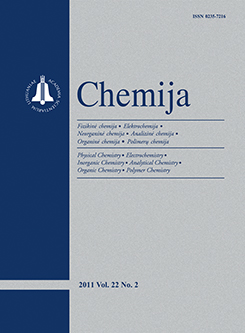Chemija / Chemistry
 ISSN 0235-7216 ISSN 2424-4538 (online) |
2015 m. Nr. 1 Cytotoxicity of anticancer aziridinyl-benzoquinones in murine hepatome MH22a cells: the properties of RH1-resistant subline
2,5-Diaziridinyl-3-(hydroxymethyl)-6-methyl-1,4-benzoquinone (RH1) is a potential anticancer agent, which underwent both preclinical and phase-I clinical trials. However, the data of the previous studies did not sufficiently distinguish the relative impact of its main mechanisms of cytotoxicity, the bioreductive activation by DT-diaphorase (NQO1), and redox cycling under the action of single-electron transferring enzymes. For the discrimination between the roles of these mechanisms, we examined the cytotoxicity of RH1 and other quinones in MH22a murine hepatoma cells and their RH1-resistant subline. In MH22a cells, the cytotoxicity of aziridinyl-unsubstituted quinones increased with an increase in their single-electron reduction potential (E17). Taken together with the protection by the antioxidants, it points to a dominating oxidative stress-type cytotoxicity mechanism. The cytotoxicity of RH1 and other aziridinyl-substituted benzoquinones was higher than expected from their E17 values. Taken together with the protection by dicumarol, it points to an additional involvement of NQO1 in the cytotoxicity. The derived subline of MH22a with 16.6-fold resistance to RH1 was not cross-resistant to duroquinone and daunorubicin. In this subline, the activity of NQ01 was decreased by 24 times, whereas the activities of NAD(P)H: cytochrome c reductases, catalase, superoxide dismutase, and glutathione reductase decreased much less significantly. It points to the dominating role of NQO1 in the cytotoxicity of RH1.
Keywords: aziridinylbenzoquinones, cytotoxicity, NAD(P)H:quinone oxidoreductase, oxidative stress |
Issues:
2017 - Vol.28 No. 1, No. 2, No. 3, No. 4 2016 - Vol.27 No. 1, No. 2, No. 3, No. 4 2015 - Vol.26 No. 1, No. 2, No. 3, No. 4 2014 - Vol.25 No. 1, No. 2, No. 3, No. 4 2013 - Vol.24 No. 1, No. 2, No. 3, No. 4 2012 - Vol.23 No. 1, No. 2, No. 3, No. 4 2011 - Vol.22 No. 1, No. 2, No. 3, No. 4 2010 - Vol.21 No. 1, No. 2-4 2009 - Vol.20 No. 1, No. 2, No. 3, No. 4 2008 - Vol.19 No. 1, No. 2, No. 3-4 2007 - Vol.18 No. 1, No. 2, No. 3, No. 4 2006 - Vol.17 No. 1, No. 2-3, No. 4 2005 - Vol.16 No. 1, No. 2, No. 3-4 2004 - Vol.15 No. 1, No. 2, No. 3, No. 4 2003 - Vol.14 No. 1, No. 2, No. 3, No. 4 2002 - Vol.13 No. 1, No. 2, No. 3, No. 4 2001 - Vol.12 No. 1, No. 2, No. 3, No. 4 |